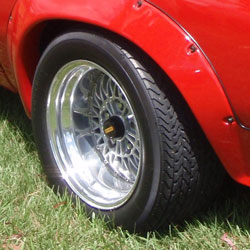
 Tyres and Tyre Information
Tyres and Tyre Information
Related Pages
Browse Tyre Prices
Tyre Compound
Tyre Treads
Tyre Maintenance
Two considerations in tyre options that are extremely important are standard tyres vs. low profile tyres. Low profile tyres have recently become very popular, but many vehicle owners are choosing them simply for aesthetic appeal while ignoring the technical side of using low profile tyres.
Low profile tyres are characterised by a diminished sidewall height, known as the aspect ratio. This is the amount of tyre that extends from the edge of the tread to the wheel. Low profile tyres can deliver increased handling but it also provides for
a bumpier ride because there is less cushioning to absorb bumps, cracks, or holes in the road.
The aspect ratio or profile rating of a tyre can be determined from the tyre’s code. The code can be found in raised characters on the sidewall of the tyre.
The first letters in the code represent the type of vehicle: P for passenger car, LT for light truck, ST for special trailer...
The next three digits represent the width of the tyre in millimetres.
After the slash is the aspect ratio. The lower the number the lower the profile.
The next character is a single letter, which represents the construction of the tyre. B is a bias belt tyre. D us a diagonal tyre, and R is a radial. If there is no letter, the tyre may be a cross ply.
After the construction code is a 2 or 3-digit number. This is the diameter of the wheel. If it is a 2-digit number, the diameter is represented in the imperial unit of inches. If it is a 3-digit number, it represents millimetres.
After a space, light trucks will have a letter code for load range. This represents the tyre’s load range. A equals a ply rating of 2. B is a ply rating of 4, and each letter through to N is another increase of ply rating by two.
 The code uses another 2 or 3-digit number that represents the load index. The load index is the maximum weight each tyre can bear at standard pressure. Understanding the code requires cross-referencing a chart. For example, code 60 is the equivalent of 250 kg, code 80 is 450 kg, and code 90 is 600 kg. A standard load index chart goes from code 60 to code 125, and the range of kilograms between each code grows as the codes reach higher numbers. At the low range, the load between each code is 7 kg, then 8 kg, then 10kg at code 68. By the time the chart gets to 100 at 800 kg, code 101 is 825 kg.
The code uses another 2 or 3-digit number that represents the load index. The load index is the maximum weight each tyre can bear at standard pressure. Understanding the code requires cross-referencing a chart. For example, code 60 is the equivalent of 250 kg, code 80 is 450 kg, and code 90 is 600 kg. A standard load index chart goes from code 60 to code 125, and the range of kilograms between each code grows as the codes reach higher numbers. At the low range, the load between each code is 7 kg, then 8 kg, then 10kg at code 68. By the time the chart gets to 100 at 800 kg, code 101 is 825 kg.
The load index of the tyres must be compared to the gross vehicle weight rating of the vehicle. This is the maximum weight including a full tank of fuel, passengers, and cargo. Always look at gross weight and not curb weight. Dividing the gross weight by the number of tyres on the vehicle will give you the value of the minimum load index each tyre must have on the vehicle.
